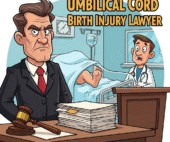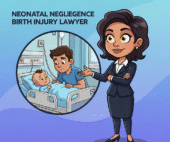The birth of a child should be a celebration, but for some families, it begins with the terrifying reality of a birth injury, particularly a Brachial Plexus Injury (BPI). These injuries, often occurring during difficult deliveries like those involving shoulder dystocia, can leave a newborn with weakness, paralysis, or limited use of an arm or hand. The immediate shock often gives way to a daunting understanding: the road to recovery will be long, arduous, and incredibly expensive, requiring extensive rehabilitation. If your child is facing this challenging journey, and you suspect their injury was preventable, the financial and emotional toll can feel overwhelming. You are not alone. Our compassionate Brachial Plexus Injury Rehabilitation Lawyers at CPFamilyHelp.com are fiercely dedicated to investigating medical negligence and securing the comprehensive compensation your child will need to fund their lifelong rehabilitation and achieve their fullest potential. When an injury demands extensive recovery, a dedicated Brachial Plexus Injury Rehabilitation Lawyer is an essential advocate.
Understanding Brachial Plexus Injuries (BPIs) and Their Impact
A Brachial Plexus Injury (BPI) involves damage to the brachial plexus, a complex network of nerves that originate from the spinal cord in the neck and control movement and sensation in the shoulder, arm, hand, and fingers. These nerves are crucial for virtually all arm functions, from lifting the shoulder to wiggling a finger.
BPIs most commonly occur during childbirth when excessive traction or stretching is applied to the baby’s head and neck during a difficult delivery, particularly in cases of shoulder dystocia (where the baby’s shoulder gets stuck behind the mother’s pelvic bone). The nerves can be stretched, compressed, torn, or, in the most severe cases, avulsed (torn away from the spinal cord).
Brachial Plexus Injury Rehabilitation Lawyer.
The impact of a BPI can range from mild, temporary weakness to complete and permanent paralysis of the affected arm. Common types of BPIs include:
- Erb’s Palsy: The most common form, typically affecting the upper nerves (C5-C6), causing weakness or paralysis in the shoulder and elbow, often resulting in the arm being held in a “waiter’s tip” position.
- Klumpke’s Palsy: A rarer form affecting the lower nerves (C8-T1), leading to weakness or paralysis in the wrist and hand.
- Global or Total Brachial Plexus Palsy: Affects all nerves of the brachial plexus, resulting in complete paralysis and loss of sensation in the entire arm.
Regardless of the specific type, a BPI often necessitates significant and ongoing rehabilitation, making the support of a Brachial Plexus Injury Rehabilitation Lawyer crucial for families.
The Critical Need for Lifelong Rehabilitation
For a child with a brachial plexus injury, rehabilitation isn’t just a recommendation; it’s a lifelong commitment that fundamentally impacts their ability to regain function and adapt to their challenges. The goal of rehabilitation is to:
- Maximize strength and range of motion in the affected limb.
- Prevent muscle atrophy and joint stiffness.
- Improve fine motor skills and coordination.
- Help the child learn compensatory movements.
- Address pain and discomfort.
- Provide adaptive strategies for daily living.
This extensive rehabilitation often includes:
- Physical Therapy (PT): Focused on improving strength, flexibility, and overall motor function through exercises, stretches, and specialized equipment.
- Occupational Therapy (OT): Helps children develop fine motor skills, hand-eye coordination, and strategies for performing daily activities (e.g., dressing, eating, writing).
- Therapeutic Exercises and Play: Engaging activities designed to encourage movement and development.
- Splinting and Bracing: To maintain proper joint alignment and prevent contractures.
- Botox Injections: To relax overactive muscles and improve range of motion.
- Pain Management: To address nerve pain or discomfort.
- Surgical Interventions: In more severe cases, nerve grafts, nerve transfers, or muscle transfers may be necessary to restore function. These are often followed by extensive post-surgical rehabilitation.
The costs associated with these therapies, specialists, equipment, and potential surgeries are immense and ongoing, highlighting why securing compensation with a Brachial Plexus Injury Rehabilitation Lawyer is so vital for a child’s long-term well-being.
Medical Negligence: Uncovering the Cause of Preventable BPIs
While some BPIs can occur even with appropriate care, a significant number are preventable and directly result from medical negligence during delivery. Our Brachial Plexus Injury Rehabilitation Lawyers meticulously investigate these critical areas of potential negligence:
- Improper Management of Shoulder Dystocia: This is the most common link. When a baby’s shoulder gets stuck, specific maneuvers (like the McRoberts maneuver, suprapubic pressure, or rotational maneuvers) must be performed correctly and without excessive force.
- Negligence: Applying excessive lateral (sideways) traction to the baby’s head or neck, or twisting the head, to free the shoulder. Failing to use appropriate maneuvers, or using them incorrectly.
- Excessive Use of Delivery Instruments:
- Negligence: Aggressive or improper use of forceps or vacuum extractors, which can put undue pressure on the baby’s head and neck nerves.
- Failure to Act on Risk Factors:
- Negligence: Not recognizing or adequately preparing for known risk factors for shoulder dystocia, such as gestational diabetes, a large baby (macrosomia), or a history of shoulder dystocia in previous births. This might involve failing to discuss or recommend a C-section when risks are high.
- Delayed C-section:
- Negligence: Persisting with a difficult vaginal delivery when it is clearly not progressing safely, increasing the risk of trauma and BPI due to prolonged attempts at extraction.
When medical professionals fail to adhere to the accepted standard of care during these challenging deliveries, and a BPI results, our Brachial Plexus Injury Rehabilitation Lawyers are here to hold them accountable.
The Lifelong Impact and Why a Brachial Plexus Injury Rehabilitation Lawyer is Essential
A severe brachial plexus injury means a child faces a future requiring continuous medical intervention and rehabilitation. The physical limitations can impact their ability to perform daily tasks, participate in sports, and eventually affect career choices and independence. The financial implications are staggering, easily reaching millions of dollars over a child’s lifetime. Securing comprehensive compensation through a medical malpractice lawsuit is not merely about financial recovery; it is about providing your child with every resource needed to achieve their highest possible level of function and live the most fulfilling life possible despite their challenges. This is precisely why the expertise of a dedicated Brachial Plexus Injury Rehabilitation Lawyer is so profoundly important.
The substantial costs that compensation typically aims to cover include:
- Ongoing Medical Treatment: Pediatric neurologists, orthopedic surgeons, physical medicine and rehabilitation specialists, and chronic pain management.
- Intensive Therapies: Lifelong physical, occupational, and sometimes speech therapy, including specialized equipment and techniques.
- Multiple Surgeries: Nerve grafts, nerve transfers, muscle transfers, tendon releases, and related post-surgical rehabilitation.
- Specialized Equipment: Orthotics, braces, adaptive devices for daily living, and mobility aids if needed.
- Home Modifications: Necessary renovations to your home to enhance accessibility and function.
- Special Education and Vocational Training: Tailored learning environments and job skills training to maximize independence.
- Personal Care Assistance: For severe cases, assistance with daily living activities.
- Loss of Earning Capacity: Compensation for your child’s diminished ability to earn an income as an adult due to permanent disability.
- Pain, Suffering, and Emotional Distress: The profound non-economic toll on the child and family.
Our dedicated team at CPFamilyHelp.com is passionate about ensuring your child receives the maximum compensation necessary to cover these extensive, lifelong needs. We are your trusted Brachial Plexus Injury Rehabilitation Lawyers, fighting tirelessly for their future.
How Our Brachial Plexus Injury Rehabilitation Lawyers Build Your Case for Justice
If you are convinced that your child’s brachial plexus injury was caused by medical negligence during delivery, you have a right to pursue a medical malpractice lawsuit. These cases are incredibly complex, demanding both profound medical understanding of obstetric mechanics and sharp legal acumen. Our Brachial Plexus Injury Rehabilitation Lawyers at CPFamilyHelp.com are uniquely equipped to handle these intricate claims.
We will:
- Conduct a Thorough and Expert-Driven Investigation: Our investigators will meticulously review all prenatal, labor, and delivery medical records, with a particular focus on details of the delivery, maneuvers used to resolve shoulder dystocia, fetal monitoring, and any documentation of force applied. We look for crucial details that indicate a deviation from the standard of care. This thoroughness is the bedrock of our practice as a Brachial Plexus Injury Rehabilitation Lawyer.
- Collaborate with Premier Medical Experts: We partner with a network of top obstetricians, neurologists, orthopedic surgeons specializing in nerve repair, physical medicine and rehabilitation specialists, and life care planners. Their invaluable professional opinion will clarify how the deviation from the standard of care led to your child’s BPI and will accurately estimate the considerable financial needs for your child’s lifetime (Life Care Planning Birth Injury). This expert collaboration is a cornerstone of our effective Brachial Plexus Injury Rehabilitation Lawyer representation.
- Navigate Complex Legal Frameworks: Birth injury lawsuits involving BPI and the need for rehabilitation are highly intricate, demanding precise adherence to legal standards. Our Brachial Plexus Injury Rehabilitation Lawyers possess deep knowledge of the specific legal mandates, procedural rules, and the important statute of limitations for birth injury claims in your state. We ensure your case is prepared flawlessly and filed within all the needed time frames.
- Assertively Pursue Maximum Recovery: Our primary goal is to achieve full compensation that covers all areas of your child’s past, current, and future needs, including all economic and non-economic damages. We fight to bring you and your family the money you need to provide the best possible care and opportunities for your child throughout their lifetime.
You and your child deserve accountability and the resources to thrive. For powerful Brachial Plexus Injury Rehabilitation Lawyer representation that truly understands your fight, turn to CPFamilyHelp.com.
Most Frequently Asked Questions (FAQ) about Brachial Plexus Injuries and Legal Action
Is every brachial plexus injury due to medical negligence?
Not every BPI is due to negligence. Some severe shoulder dystocia cases can result in BPI even with proper management. However, a significant number of injuries are caused by excessive or improper force during delivery. A skilled Brachial Plexus Injury Rehabilitation Lawyer can help determine if negligence was a factor.
What is the primary cause of brachial plexus injuries during birth?
The primary cause is excessive stretching or traction on the baby’s head and neck during delivery, most commonly when the shoulder gets stuck (shoulder dystocia).
Can a child fully recover from a brachial plexus injury?
Recovery varies greatly. Mild stretches (neuropraxia) often recover fully within weeks or months. More severe injuries (ruptures, avulsions) may result in permanent weakness or paralysis, even with extensive surgery and rehabilitation. The goal is always to maximize function.
How does rehabilitation help a child with a brachial plexus injury?
Rehabilitation, including physical and occupational therapy, aims to improve muscle strength, increase range of motion, prevent joint stiffness and contractures, and help the child learn adaptive strategies to use their arm and hand more effectively. Early and consistent therapy is critical.
What kind of evidence is crucial in a brachial plexus injury claim?
Key evidence includes detailed labor and delivery medical records (especially notes on delivery maneuvers, use of force, and fetal monitoring), expert medical testimony from obstetricians and neurologists, and documentation of the child’s rehabilitation needs and prognosis. A thorough Brachial Plexus Injury Rehabilitation Lawyer will gather and analyze all this crucial documentation.
If you feel your child’s brachial plexus injury was preventable due to medical negligence, and you’d like to discuss your case with a lawyer, don’t hesitate. For experienced and compassionate Brachial Plexus Injury Rehabilitation Lawyer service, we encourage you to Contact Trusted Birth Injury Lawyers | CPFamilyHelp today for a free and confidential review. We hear you, we advise you, and we advocate for your child’s future.




